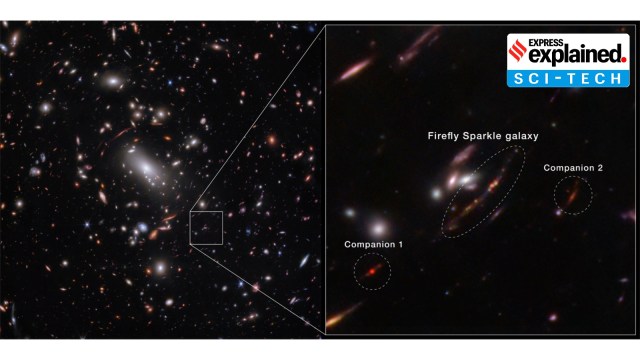How a distant galaxy gave a glimpse of Milky Way in its infancy
Firefly Sparkle is among the earliest galaxies humans have observed, which formed merely some 600 million years after the Big Bang
 Firefly Sparkle Galaxy and companions in Galaxy Cluster MACS J1423. (Photo: WEBB Space Telescope)
Firefly Sparkle Galaxy and companions in Galaxy Cluster MACS J1423. (Photo: WEBB Space Telescope)NASA’s James Webb Space Telescope (JWST) has spotted a distant galaxy which gives a peek at what the Milky Way might have looked like in its infancy. The galaxy, named Firefly Sparkle due to its gleaming star clusters resembling the bioluminescent bugs (a group of fireflies is called a “sparkle”), is located some 13 billion lightyears away, meaning it took light 13 billion years to travel from the galaxy to.
Given that the Big Bang — the cosmic event that initiated the cosmos — occurred approximately 13.8 billion years ago, Firefly Sparkle, as we observe it today, is an infant galaxy formed in the immediate aftermath of the beginning of everything. Researchers say that the galaxy, still in the process of assembling, is estimated to have formed 100-400 million years before its evolutionary stage observed by the JWST.
Like Milky Way
Firefly Sparkle has a mass equal to about 10 million stars the size of our sun, and comprises 10 densely packed star clusters embedded in a diffuse arc of stars. Its main visible portion spans about 1,000 light-years across. It has two other relatively smaller galaxies as neighbors, dubbed Firefly-Best Friend and Firefly-New Best Friend.
“The Milky Way began forming very early in the universe’s history, likely around the same time as Firefly Sparkle,” astronomer Lamiya Mowla, co-lead author of the study published on Wednesday in the journal Nature, told Reuters.
“This observation gives us a direct look at what galaxies like our Milky Way might have looked like in their infancy. Using simulations and statistical methods, we find that the Firefly Sparkle’s mass is consistent with what we’d expect for a Milky Way ancestor at that early time. At this stage, the galaxy was about 10,000 times less massive than our current Milky Way, which is typical of galaxies at that epoch,” Mowla said.
Study co-lead author Kartheik Iyer said that “the Milky Way continued to grow and evolve over billions of years through mergers with other galaxies and continued star formation, while we’re seeing Firefly Sparkle in its initial formation stages”.
Gravitational lensing
JWST is the most advanced telescope fashioned yet, and has given humans the ability to look across vast distances — and thus back in time, as light takes time to travel. But Firefly Sparkle is so small and so very far away that not even the JWST would have been able to observe it, were it not for a lucky cosmic coincidence.
Between the JWST and Firefly Sparkle were a cluster of galaxies which distorted spacetime such that the light from the faraway galaxy was stretched, and effectively amplified. Astronomers refer to this phenomenon as gravitational lensing.
“[Gravitational Lensing] takes the light coming from the Firefly and bends it and amplifies it so we can see it in glorious detail,” Iyer told the BBC, saying that the cluster of galaxies effectively acted like a giant magnifying glass.
“In this study, the foreground galaxy cluster magnified the light from Firefly Sparkle by about 16-26 times, making it possible to see details that would otherwise be too faint to observe,” Iyer said.
With inputs from Reuters
- 01
- 02
- 03
- 04
- 05






































